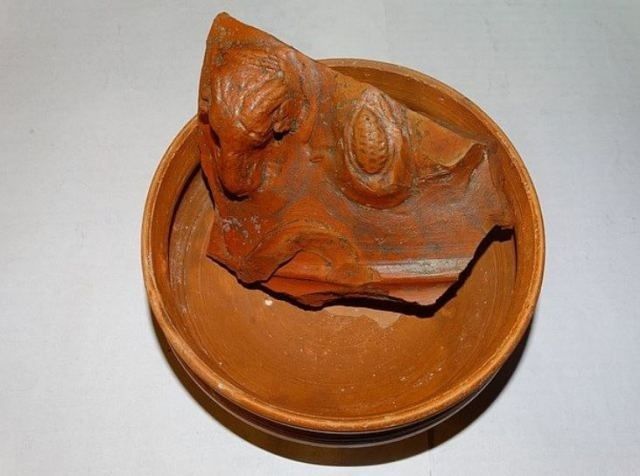Post by UKarchaeology on Aug 16, 2015 20:27:07 GMT

The archaeologists excavating the Ancient Roman villa and ceramic factory located in the northern Bulgarian town of Pavlikeni have discovered a ram head pottery decoration, among other Antiquity artifacts.
The ram head decoration is probably the most interesting of the items discovered in the 2015 summer excavations of the Ancient Roman ceramic factory, after in June 2015 the archaeologists working in Bulgaria’s Pavlikeni found four more Roman pottery kilns in what is believed to have been an unknown Roman town located near the Ancient Roman villa and ceramic factory.
The ram head application is found on a fragment of a ceramic vessel which was probably used for religious purposes, reports Darik Radio citing the archaeologists conducting the digs in Pavlikeni.
The excavations of the Ancient Roman ceramic factory have been conducted for the second consecutive year, after a 35-year pause; the site was first excavated by Bulgarian archaeologist Bogdan Sulton back in 1971. The current digs are sponsored jointly by Pavlikeni Municipality, the Pavlikeni Museum of History, the Veliko Tarnovo Regional Museum of History, and the Veliko Tarnovo University “St. Cyril and St. Methodius”.
The team working on the further research of the Ancient Roman ceramic factory is led by archaeologist Kalin Chakarov from the Pavlikeni Museum of History and Assoc. Prof. Dr. Oleg Alexandrov, head of the Archaeology Department of the St. Cyril and St. Methodius University.
In addition to the new ancient artifacts, the archaeologists have also revealed new archaeological structures which have been found through underground scanning conducted by Assist. Prof. Dr. Hristiyan Tsankov and Ass. Prof. Atanas Kisyov from the Applied Geophysics Department of the St. Ivan Rilski University of Mining and Geology in Sofia.
The archaeological team has excavated precisely the most promising structures detected with the underground scanning.
Pavlikeni Municipality has recently started the partial restoration of the Ancient Roman ceramic factory at a Roman military veteran’s villa estate after winning a grant from the European Economic Area and Norway Grants mechanism worth EUR 736,000.
The project for the restoration of the Roman pottery-making center is being carried out by Pavlikeni Municipality in partnership with the Pavlikeni Museum of History, and is to be completed by the end of April 2016.
(source/pics: archaeologyinbulgaria.com/2015/07/30/archaeologists-find-ram-head-pottery-decoration-in-ancient-roman-ceramic-factory-in-bulgarias-pavlikeni/ )
Background Info notes;
The Ancient Roman ceramic factory and Roman military veteran’s villa near the town of Pavlikeni in Central Northern Bulgaria was found in 1971 by Bulgarian archaeologist Bogdan Sultov who excavated it for about a decade. It is the only known Ancient Roman ceramic factory in Southeast Europe. The Ancient Roman ceramic production center near Pavlikeni is located on a plot of 139 decares (app. 34.3 acres). It was part of the villa estate of a Roman military veteran, and is dated to the end of the 1st century AD. The ceramic production started at the beginning of the 2nd century AD. Archaeological excavations have revealed a total of 52 furnaces for baking household and construction ceramics which was traded and sold in the entire region. The Ancient Roman villa estate with its ceramic factory was destroyed at the end of the 2nd century AD in a barbarian invasion by the Goths. The excavations of the Roman ceramic center near Pavlikeni were terminated in the 1982, and were resumed only in the summer of 2014 with minor funding from Pavlikeni Municipality. In 2015, the Municipality and the Pavlikeni Museum of History won a EUR 736,000 grant for the partial restoration and rehabilitation of the site. In addition to Ancient Roman buildings and furnaces, the excavations there have revealed numerous ceramic vessels, tools, jewelry, and even Ancient Roman child toys.
